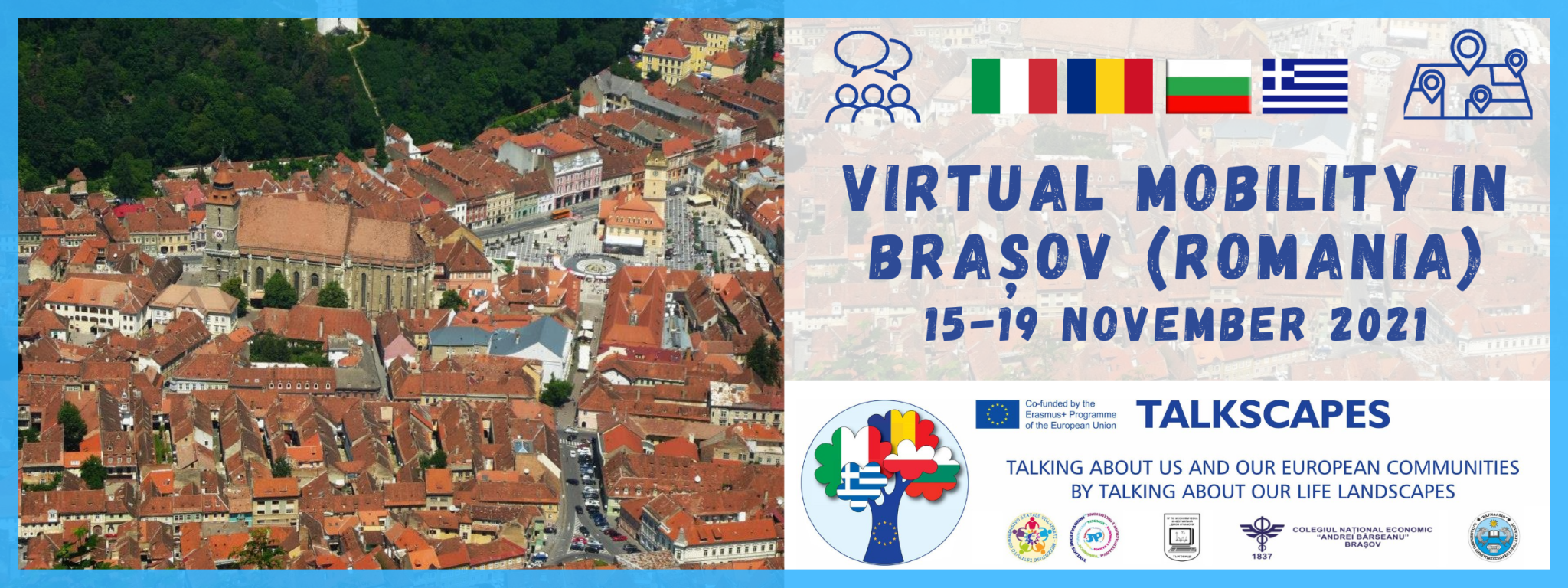
Due to the persistent COVID-19 pandemic situation, the whole activity has been realized just in an online modality, through five web meetings that have been held during the afternoon of each day of virtual mobility.
During the virtual mobility activities, the socio-cultural and territorial context, and landscape case studies relevant to the City of Brasov, localized in Transylvania, in the central part of the Country, and other Romanian cities, places, monuments and traditions, have been focused.
The executive program has been defined as follows:
– Monday, 15th November: Welcome and presentation of the working group and virtual tour in Brasov, between traditional songs and tourist landmarks.
– Tuesday, 16th November: Virtual trip to the old city of Brasov and discovery of Romanian traditional dances.
– Wednesday, 17th November: Virtual trip to Schei, the oldest neighborhood of Brasov, and discovery of the Junii Brasovului and the County Churches.
– Thursday, 18th November: Virtual trip to Mount Tampa, Poiana Brasov, Rasnov, Fagaras, Zarnesti, Peles Castle, and educational word games.
– Friday 19th November: Discovering the Bran Castle and the Haunted Castle. Virtual trip through the Romanian workgroup favorite places and final quiz. Feedbacks, ideas, and open perspectives for next visits on-site.
A part of the mobility days has been dedicated to common laboratory activities leaded by the Project Team and the representatives of each partner School’s Local Coordinating Team, in order to systematize, analyze, discuss and prepare data and other resources to digitally map and describe in multilanguage modality all landscape configuration and case studies visited.
All participants have been involved directly and personally in discovering Romanian landscapes, experiencing the similarities and differences between their own respective geographical landscapes as well as historical ones.
Starting from the territory relevant to the Colegiul National Economic “Andrei Barseanu” in Brasov, and through online presentations and very suggestive media, Students and Teachers from the Romanian School have guided their peers and colleagues in the discovery of Brasov and its touristic highlights and landscape landmarks, the old city and Brasov County Churches, the interesting legends related to these places.
All participants have enjoyed the virtual journeys through natural landscapes, through the amazing Castles, and Hungarian, German and Romanian traditions that characterizing the Transylvania Region. This experience has stimulated all participants Students and Teachers to share next deeper comparisons between National/local cultures of their respective European Countries.
At the end of the mobility all participants have demonstrated their happiness and satisfaction to have met their Bulgarian, Romanian and Italians peers and colleagues, thank to such a fruitful and exciting cultural interchange occasion.
The critical thinking has been applied to the broadening of cultural horizons. Along with the improvement of communication skills in English language, a very interesting activity has been represented by the learning of foreign words and especially Romanian ones. All participating have gained firsthand knowledge of Europe’s cultural diversity, but also are became more aware of the role that each local community plays, with its uniqueness in the European framework and through its different landscapes and takscapes.
Poster_vurtual_mobiliy_in_Brasov di Maria Laura Scaduto
Romanian landscape case studies
During the virtual mobility in Brasov (Romania) and in view of the implementation of the EYLIM, the Romanian Local Workgroup elaborated and shared multimedia presentations, videos and games about:
– Brasov and its tourist landmarks
– The historic city of Brasov
– Churches of Brasov
– Zarnesti
– Poiana Brasov
– Peles
– Rasnov
– Hungarian, German and Romaniantraditions
– Romanian traditional clothes
– Tampa
– Our favourite places
– Bran Castle
– Schei
– Viscri
